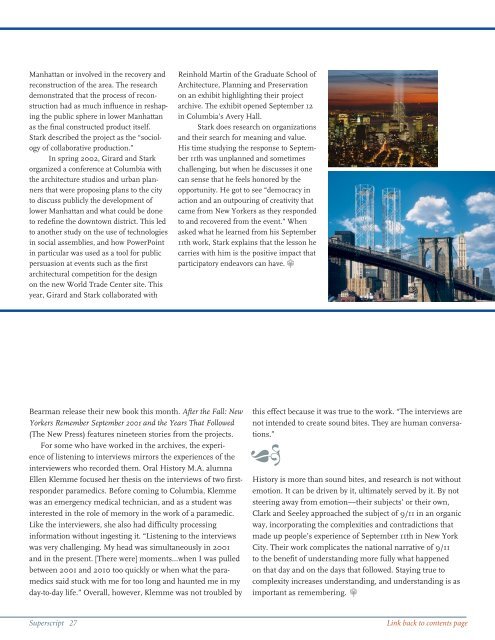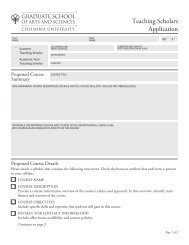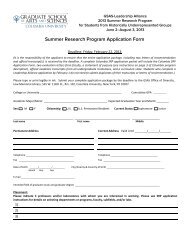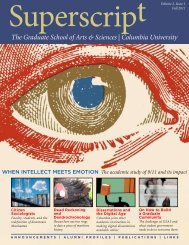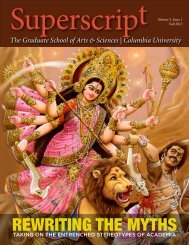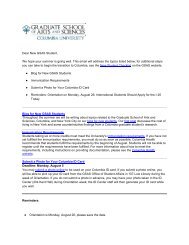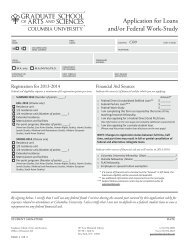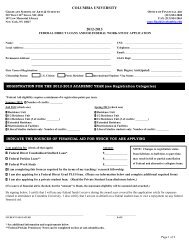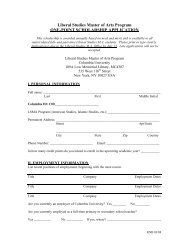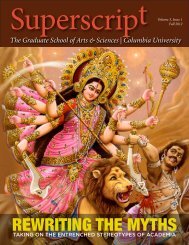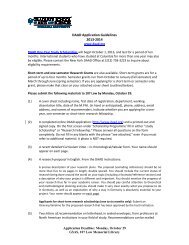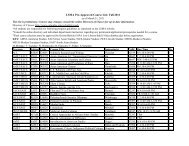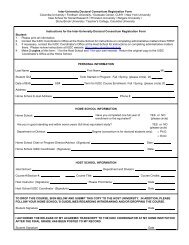Citizen SociologistsDavid Stark, ArthurLehman Pr<strong>of</strong>essor<strong>of</strong> Sociology<strong>and</strong> InternationalAffairs, was in themidst <strong>of</strong> fieldworkstudying traders atthe World Financial Center on September11, 2001. On the day itself, he <strong>and</strong> DanielBeunza, a graduate student working withhim, decided to stay on campus to discussthe project instead <strong>of</strong> heading downtown.When the WFC was destroyed, Starkassumed their work had come to anindefinite end. He waited until tradingresumed six days later to call his contactat the company, now operating in NewJersey, <strong>and</strong> ask if everyone was all right.When Stark said he would call againafter time had passed, his contact quicklyreplied, “No, you won’t.” He insistedStark <strong>and</strong> Beunza resume their researchimmediately. He told Stark that theymust “witness what was going on in therecovery room in New Jersey. We werethe only social scientists working in [theWFC then], <strong>and</strong> he told me that it was<strong>of</strong> historical importance.” Being invitedinto a community at such a time was “thehighest honor to an ethnographer.”The uniqueness <strong>of</strong> the situationyielded questions <strong>and</strong> observations Starkwould not have come across otherwise.In the end, his research with the tradersfocused on recovery as a <strong>for</strong>m <strong>of</strong> innovationwithin an organization. “Recovery isa response to extreme uncertainty,” <strong>and</strong> itrequires a group <strong>of</strong> people to respond tochallenge in new ways. It quickly becameclear to Stark <strong>and</strong> his students that suchinnovation was not confined to organizationsalone. It could be studied in all<strong>of</strong> lower Manhattan. Stark recalls oneevening in October 2001 when he <strong>and</strong> hiswife <strong>and</strong> fellow social scientist MoniqueGirard hosted a dinner with students,<strong>and</strong> Girard declared that the “time <strong>for</strong>giving blood was over. We were socialscientists, <strong>and</strong> we needed to use our workto do something <strong>for</strong> the city.” It was a callto arms. Several students halted work ontheir dissertations <strong>and</strong> Stark <strong>and</strong> his wifeset aside projects in order to study theresponse <strong>and</strong> recovery ef<strong>for</strong>ts in the city.Stark remembers thinking, “We are here.There are important lessons to learn, <strong>and</strong>we have to do this. It was an extension <strong>of</strong>our underst<strong>and</strong>ing <strong>of</strong> what it meant to bea social scientist in New York at that time.We had to respond ourselves <strong>and</strong> takeresponsibility as citizens.”Their research focused on <strong>for</strong>ms <strong>of</strong>,in Stark’s words, “public assemblies”—such as not-<strong>for</strong>-pr<strong>of</strong>it organizations, largecompanies, select pr<strong>of</strong>essions, <strong>and</strong> publicdemonstrations—operating in downtown‘You can’t move around suffering. You have to move throughit. You have to acknowledge it be<strong>for</strong>e you can analyze it.’” Inretrospect, Clark is glad to have brought the NYU psychologistteam to the Narrative <strong>and</strong> Memory Project in its laterdevelopment. After a year <strong>of</strong> recording stories, the work hadbegun to wear on the interviewers <strong>and</strong> the <strong>of</strong>fer <strong>of</strong> free therapysessions became a necessary resource. “It was a relief to me tohave someone to call if something happened in the field that Ineeded to talk about.”Despite its emotional impact, Seeley believes trauma studyis helpful to her work as an anthropologist <strong>and</strong> psychotherapist.“People’s subjectivities are important. It is very dangerouswhen we only look at disasters in a distanced or clinical way.I don’t think you have to take the emotion out <strong>of</strong> academicwork. Instead, we need to find ways to put emotion back in sowe can better underst<strong>and</strong> what happens to those who experiencetraumatic events <strong>and</strong> to those who study them.” However,there is a balance between being open to emotion <strong>and</strong>taking in too much. Seeley now teaches a course on trauma.While she encourages students not to shy away from traumastudy, she also warns that students with trauma in their backgroundshould take care if they decide to remain in the class.Like Seeley, Clark feels that emotion is necessary <strong>for</strong> theintegrity <strong>of</strong> research. It is not possible to separate oneself fromthe emotion <strong>of</strong> the work, <strong>and</strong> one should not wish to do so. “Apart <strong>of</strong> oral history is to not make that divorce. We will alwaysrespect the suffering <strong>of</strong> people <strong>and</strong> at the same time be able tost<strong>and</strong> back <strong>and</strong> use our brains to analyze.”Time is also beneficial. “It takes time to make meaning,”explains Clark. “Oral history is a process, not a product.” TheSeptember 11, 2001 oral history archives have been open<strong>for</strong> more than a year. They have been used by students <strong>and</strong>researchers, but their existence has remained relatively quiet.This may change after they are <strong>of</strong>ficially opened <strong>and</strong> Clark <strong>and</strong>Link back to contents page26 Superscript
Manhattan or involved in the recovery <strong>and</strong>reconstruction <strong>of</strong> the area. The researchdemonstrated that the process <strong>of</strong> reconstructionhad as much influence in reshapingthe public sphere in lower Manhattanas the final constructed product itself.Stark described the project as the “sociology<strong>of</strong> collaborative production.”In spring 2002, Girard <strong>and</strong> Starkorganized a conference at <strong>Columbia</strong> withthe architecture studios <strong>and</strong> urban plannersthat were proposing plans to the cityto discuss publicly the development <strong>of</strong>lower Manhattan <strong>and</strong> what could be doneto redefine the downtown district. This ledto another study on the use <strong>of</strong> technologiesin social assemblies, <strong>and</strong> how PowerPointin particular was used as a tool <strong>for</strong> publicpersuasion at events such as the firstarchitectural competition <strong>for</strong> the designon the new World Trade Center site. Thisyear, Girard <strong>and</strong> Stark collaborated withReinhold Martin <strong>of</strong> the <strong>Graduate</strong> <strong>School</strong> <strong>of</strong>Architecture, Planning <strong>and</strong> Preservationon an exhibit highlighting their projectarchive. The exhibit opened September 12in <strong>Columbia</strong>’s Avery Hall.Stark does research on organizations<strong>and</strong> their search <strong>for</strong> meaning <strong>and</strong> value.His time studying the response to September11th was unplanned <strong>and</strong> sometimeschallenging, but when he discusses it onecan sense that he feels honored by theopportunity. He got to see “democracy inaction <strong>and</strong> an outpouring <strong>of</strong> creativity thatcame from New Yorkers as they respondedto <strong>and</strong> recovered from the event.” Whenasked what he learned from his September11th work, Stark explains that the lesson hecarries with him is the positive impact thatparticipatory endeavors can have.Bearman release their new book this month. After the Fall: NewYorkers Remember September 2001 <strong>and</strong> the Years That Followed(The New Press) features nineteen stories from the projects.For some who have worked in the archives, the experience<strong>of</strong> listening to interviews mirrors the experiences <strong>of</strong> theinterviewers who recorded them. Oral History M.A. alumnaEllen Klemme focused her thesis on the interviews <strong>of</strong> two firstresponderparamedics. Be<strong>for</strong>e coming to <strong>Columbia</strong>, Klemmewas an emergency medical technician, <strong>and</strong> as a student wasinterested in the role <strong>of</strong> memory in the work <strong>of</strong> a paramedic.Like the interviewers, she also had difficulty processingin<strong>for</strong>mation without ingesting it. “Listening to the interviewswas very challenging. My head was simultaneously in 2001<strong>and</strong> in the present. [There were] moments…when I was pulledbetween 2001 <strong>and</strong> 2010 too quickly or when what the paramedicssaid stuck with me <strong>for</strong> too long <strong>and</strong> haunted me in myday-to-day life.” Overall, however, Klemme was not troubled bythis effect because it was true to the work. “The interviews arenot intended to create sound bites. They are human conversations.”jHistory is more than sound bites, <strong>and</strong> research is not withoutemotion. It can be driven by it, ultimately served by it. By notsteering away from emotion—their subjects’ or their own,Clark <strong>and</strong> Seeley approached the subject <strong>of</strong> 9/11 in an organicway, incorporating the complexities <strong>and</strong> contradictions thatmade up people’s experience <strong>of</strong> September 11th in New YorkCity. Their work complicates the national narrative <strong>of</strong> 9/11to the benefit <strong>of</strong> underst<strong>and</strong>ing more fully what happenedon that day <strong>and</strong> on the days that followed. Staying true tocomplexity increases underst<strong>and</strong>ing, <strong>and</strong> underst<strong>and</strong>ing is asimportant as remembering.Superscript 27Link back to contents page


